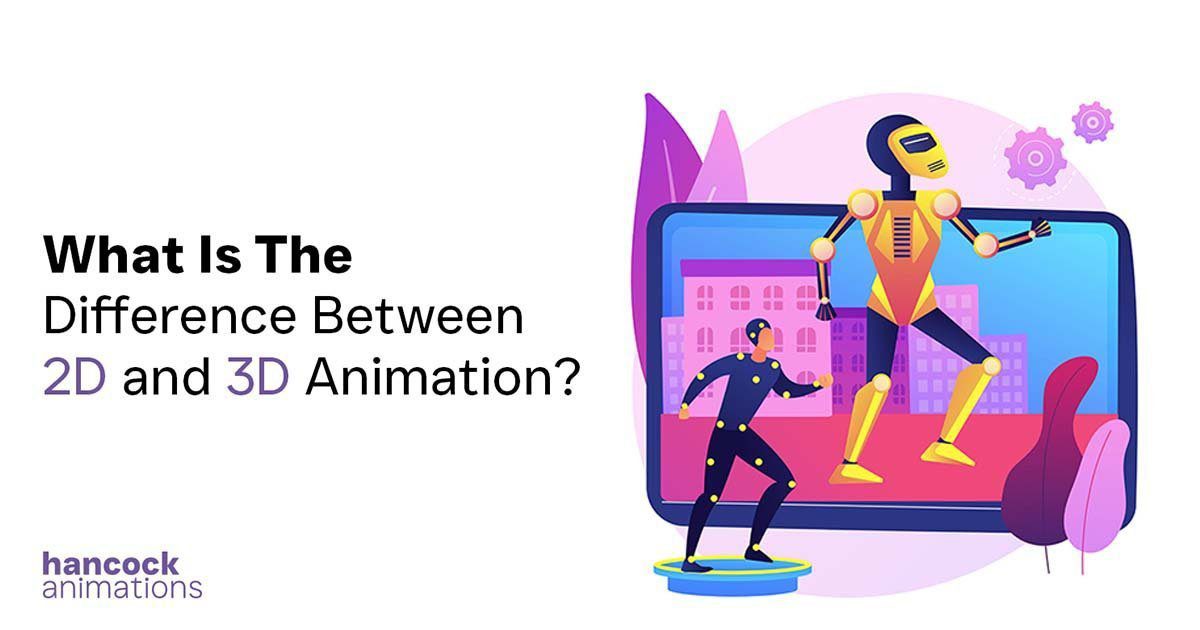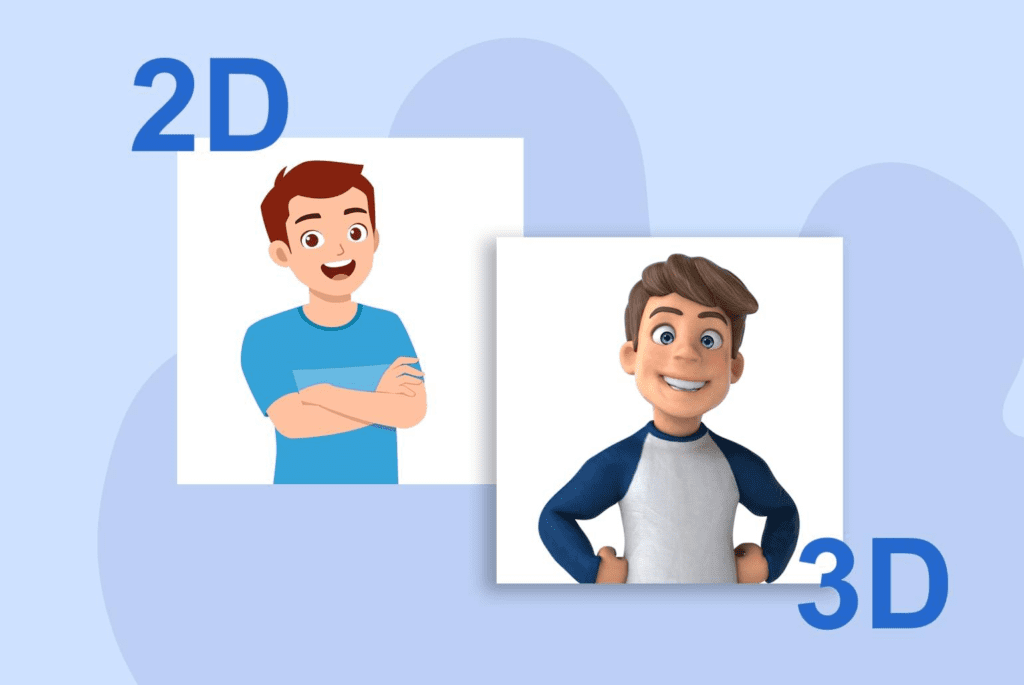What Is The Difference Between 2D And 3D Animation?

With the rising demand for video content, 2D animation and 3D animation always succeed in being the driving force behind various film studios, corporations, educational institutions, and other industries. Its visually pleasing graphics continue to fascinate people and can aid in schooling and entertaining audiences.
Many brands are reaching out to 2D and 3D animation experts to enhance their video content such as how-to videos, demo videos, brand and promotional videos, and other such video formats that not only help brands spread awareness but also capture their target audience’s attention.
But what separates 2D animation from 3D animation services? Which one is a better pick? Which one would be suitable for your business purposes? At Hancock Animations, we understand the nuances between 2D and 3D animation and can guide you toward the best choice for your specific needs.
For more detailed insights and a comprehensive understanding of how 2D and 3D animation distinguish from one another, read this article and make informed decisions tailored to your business needs.
What Is 2D Animation?
2D animation refers to the creation of movement in a two-dimensional space. Traditionally, this was achieved through hand-drawn illustrations, where animators would draw each frame of an animated sequence with slight variations to simulate motion. These individual frames would then be compiled together to form the illusion of movement, with typically 24 frames per second of animation.
However, with the advancement of technology, traditional hand-drawn methods have been largely replaced by various software tools like Adobe Photoshop, Illustrator, Toon Boom Harmony, and others. These digital tools have streamlined and modernized the process, enabling animators to work more efficiently. Consequently, animators can now produce 2D animation clips in a matter of weeks rather than the longer duration it would have taken with traditional methods.
This advancement in technology has also made 2D animation more cost-effective, allowing production companies to achieve their desired video content within reasonable budgets.
Advantages And Disadvantages Of 2D Animation
2D animation remains a prominent and versatile choice across various forms of media due to its enduring appeal and flexibility in different content domains. While it’s a popular and effective medium, like any technology or art form, it possesses both advantages and disadvantages.
Advantages
- 2D animation is relatively cheaper as compared to 3D animation. The simplistic nature of 2D and the use of less complicated software tools allows businesses to get the video they expect on their prescribed budget.
- Artists or 2D animators can easily dive into the know-how of 2D animation. It is easier to understand and the effortless implementation process is just its plus point. The reduced amount of technology also cuts its difficulty which also results in the reduction of production time.
- The simple but effective visual appeal of 2D animation allows the users to be fully immersed in the story of the purpose behind the video. While 3D animation relies more on the “wow” factor, 2D animation is more story-oriented and helps viewers indulge in the content rather than just the visual aspects of the video.
Disadvantages
- Since 2D animation only works on two dimensions (height and width), it can sometimes come off as dull or repetitive. Its lack of movement in other directions does not give a lot of creative space to 2D animators to come up with unique character designs or provide an outstanding visual experience as compared to 3D animation.
- Ever since 3D animation came into existence, the demand for 2D animation has somewhat declined. The technological advancements that come with 3D animation are unmatchable as compared to 2D animation and thus, are getting more preference from people.
- Since 2D animation still relies on drawing every single frame, the process of animation could be time-consuming for both 2D animators and business owners.
What Is 3D Animation?
3D animation, also referred to as three-dimensional animation, involves working within three dimensions: height, width, and depth. The process typically begins with creating three-dimensional models of characters, backgrounds, or objects. These models are then animated to bring them to life.
For 3D animators, there’s a significant level of freedom and flexibility. They have the ability to manipulate various character features, create visually stunning backgrounds, and craft unique and exciting visual experiences. The depth in 3D animation allows them to create lifelike simulations, realistic movements, and the creation of immersive environments.
Technological advancements have popularized 3D animation in entertainment like movies and gaming due to its realistic and captivating visuals. However, its technical complexity and specificity limit its use in some corporate and marketing strategies.
Yet, the immersive and realistic quality of 3D animation makes it an excellent choice for creating visually striking content, offering unique experiences not achievable in other animation forms.
Advantages And Disadvantages Of 3D Animation
While 3D animation is getting high recognition and has a great ROI (return on investment), it also has its limitations which both the 3D animators and brands must know about. Here are some of the benefits and drawbacks of 3D animation:
Advantages
- 3D animation can give a natural appeal to your video content and the animation looks more crisp and clean. The dynamic nature of 3D allows 3D animators to create a single model and utilize it in multiple ways without having to redo the whole animation process.
- 3D animators and artists have a bigger and better canvas to display their skillfulness and incorporate new ideas, concepts, character designs, and backgrounds to create something out of the box. For instance, a 2018 3D computer-animated feature “Spiderman: Into the Spider-Verse” was highly praised for its groundbreaking animation style and set a new benchmark for animators to get out of their comfort zone.
- The complex but modern approach to 3D technology gives you unlimited options for 3D graphics. They can create impossible or difficult animations which was not possible before with 2D animations.
- While 2D animation is nowhere going to be outdated soon, its demand has slowed down since the arrival of 3D animation. Its rising popularity due to a series of successful ventures by Disney, Pixar, Marvel, and other production houses has made it a dominating form of animation.
Disadvantages
- The software tools and technology used for 3D animation are more complicated than that of 2D animation. You cannot determine the final look of a 3D model unless you finish it up. If the outcome is not what you expected, you will then have to re-model the motion and then add other features such as lighting, creating characters, adding textures, and others.
- The production time required for 3D animation is long and exhausting because of the complex procedures of 3D animation, and then casting voice actors and creating a script for the video.
- Even after the exhilarating experiences delivered through 3D animated content, the rig puts a creative restriction on your video content and you are forced to use the same basic model over and over again. Hence, 3D animation could be difficult to stylize as compared to 2D animation.

2D Animation Vs. 3D Animation
While both of these animation styles have their unique perspectives, here are the following points that separate them from each other:
- 2D animation views the video content in a flat landscape due to its two-dimensional nature, whereas, 3D animation showcases characters, backgrounds, objects, or models in a three-dimensional landscape.
- 2D animation has a short production time compared to 3D animation unless the 2D artist draws each frame with their own hands.
- Due to the complex technology and software tools used in 3D animation, it is more expensive than 2D animation and the costs will only go up with additional features.
- With more realistic options and textures available on 3D animation software, it allows you to change camera angles and lighting wherever necessary. Their high-performing tools are apt for complex or high-end industries such as media, medical, engineering, and other similar industries.
Wrapping Up…
Both 3D animation and 2D animation hold their significance in the market, and neither is likely to fade from the marketplace anytime soon. Choosing the right animation style that perfectly aligns with your business objectives is pivotal for achieving your goals.
For those aiming to compel their target audience through effective storytelling and a touch of artistic charm, 2D animation stands out as an ideal choice. Its simplicity and nostalgic appeal often resonate well with audiences seeking relatable and engaging content.
On the other hand, if your aim is to let the animation itself make a powerful impact, providing highly detailed and immersive visual experiences, then 3D animation might be the perfect fit. Its ability to create lifelike simulations and intricate visual environments can leave a lasting impression on viewers.
Ultimately, the outcome should align with your business goals, satisfying your target audience, and driving the sales and revenue you desire to generate. The choice between 2D and 3D animation depends on your brand’s narrative, target audience, and the specific impact you wish to create.
Looking for stunning and detailed visuals?
Our professional 3D animation services can bring your ideas to life.
Production time varies based on the complexity and duration of the project but can range from a few weeks to several months.
Software like Adobe Animate, Toon Boom Harmony, and TVPaint Animation are popular tools for 2D animation.
Software like Autodesk Maya, Blender, Cinema 4D, and 3ds Max are popular tools for 3D animation.
3D animation is widely used in movies, video games, architectural visualization, product modeling, and various industries requiring highly detailed and realistic visuals.

